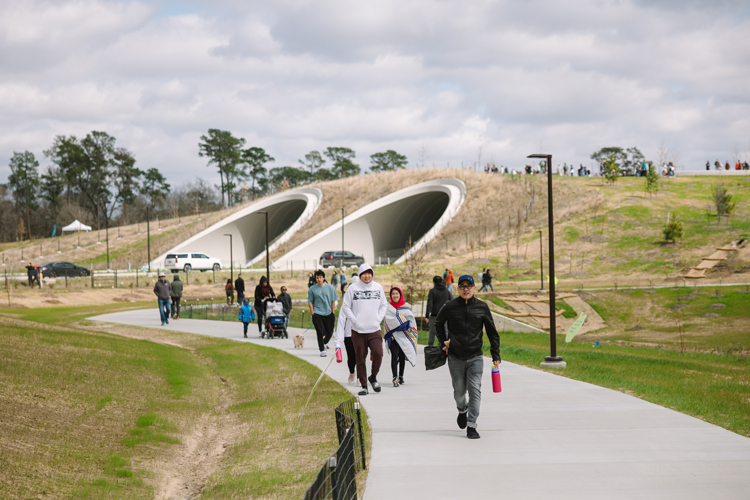Spearheading Memorial Park’s Transformation
Shellye Arnold oversees progress on the 10-year master plan.

In February, the Memorial Park Conservancy formally debuted the most recent additions to Houston’s largest urban greenspace. Memorial Park—a favorite of runners, walkers, and wildlife—now boasts the Kinder Land Bridge & Cyvia and Melvyn Wolff Prairie, which together form a key element of the Conservancy’s 10-year master plan.
“Projects like these take a village to make them happen,” according to Shellye Arnold, Memorial Park Conservancy’s president and CEO. “Our project partners, our donors, our very talented staff—all of us have come together to bring these improvements [that have been] heralded as one of the most architecturally innovative projects in the world by the New York Times and Architectural Digest. These projects will elevate the park—and Houston—in a positive way, on a national and global level. It will change the way people think about Houston.”
The land bridge and prairie restoration will also improve the way that the park works, especially when it comes to flood mitigation. The nearly 45 acres of restored native coastal prairie within Memorial Park will ensure greater resilience during flooding events, expand the park’s stormwater management capacity, and improve animal and insect habitats. (Native coastal prairie is the rarest ecosystem in Texas, and less than 1 percent of it remains intact.)
Memorial Park is probably known by most residents for its multi-mile Seymour Lieberman Exercise Trail—the single most-used free public health amenity in the city, and the most popular jogging trail in the nation. The trail sees an average of 10,000 runners (and walkers) daily. In the past, famous Houstonians like First Lady Barbara Bush could be spotted there getting her exercise.
Established in 1924 by the City of Houston, the park has been a favorite spot for golfers, sports teams, marathon trainers, and the like. “People from over 170 zip codes and from all walks of life visit Memorial Park on a regular basis. It is Houston’s park, and we make sure that we steward a space that is welcoming to all users who want to enjoy it. This expansion will provide even more opportunities to make that happen,” says Arnold.
The land bridge and prairie restoration are only the most recent projects to be unveiled. Improvements have been in the works since 2015, when a master plan designed by the landscape-architecture firm Nelson Byrd Woltz was unanimously approved by the Houston City Council. That plan is now being developed by the Conservancy in partnership with the Houston Parks and Recreation Dept., Uptown Development Authority, and the Kinder Foundation, along with input from over 3,000 Houstonians, 75 scientists, and other experts. A generous multi-million dollar contribution from the Kinder Foundation greatly increased the pace of development, enabling early completion of the Eastern Glades and the first phase of the Sports Complex.

The land bridge accomplishes a major goal of the master plan by reuniting the two halves of Memorial Park that were formerly bifurcated by the six-lane Memorial Drive. This caused safety issues for park users and created a barrier for wildlife trying to access their natural habitat. Now, both of those issues are solved in a way that also adds some impressive views from the land bridge while cars zip through the tunnels underneath it.
Arnold, a lesbian native Houstonian, is celebrating ten years with the Conservancy just as these exciting projects are being unveiled. “I joined to help lead this transformation of Memorial Park. After the 2011 drought devastated so much of Houston and the park, it became clear that a recommitment to making Memorial Park reach its full potential was necessary,” she says.
She credits her partner of 34 years, Tina Sabuco, with helping to keep her focused during this huge undertaking that has consumed so much of Arnold’s attention. “Tina has been a tremendous supporter of my work at Memorial Park,” Arnold notes.
The Conservancy Board has also demonstrated their commitment to diversity, equity, and inclusion by formally adopting those priorities as part of their strategic plan. Arnold is proud of the hard work it took to put a board and staff together that represents this city’s many voices. It’s an important factor, given the park’s size and prominence, and a key part of its continuing success.
For more info on volunteering and donations, visit memorialparkconservancy.org











Comments